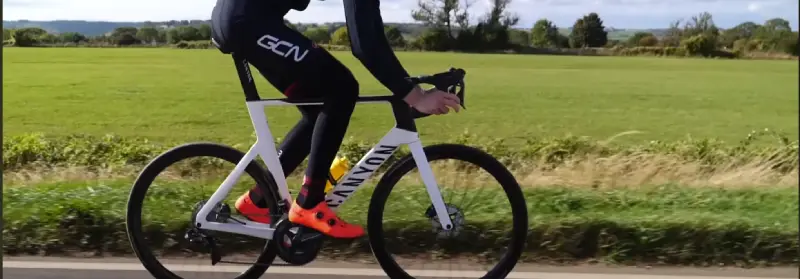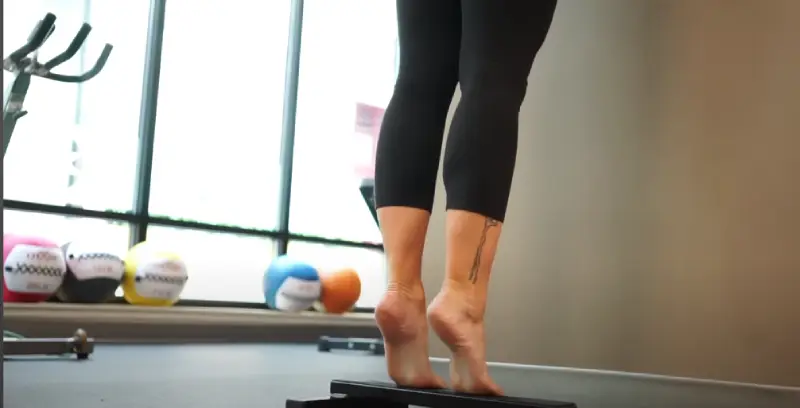Cycling regularly helps you build calf muscles by engaging them during pedaling. The repetitive motion of pedaling strengthens your calf muscles over time. Include biking in your routine to tone and strengthen your calves effectively.
You can build calf muscles while cycling if you ride in higher gears and include hill climbs. Off-bike exercises like calf raises and cross-training activities like running can complement cycling. Incorporate squats and weighted calf raises in your routine to build calf muscle mass effectively.
This post will explore techniques for building those calf muscles and common mistakes to avoid so you can reach your fitness goals.
Key Takeaways
➢ Pedal Technique: Use the entire leg, focusing on circular motion.
➢ Push/Pull: Apply force downwards and upwards for muscle engagement.
➢ Resistance: Increase gear for higher resistance, akin to weightlifting.
➢ Climbing: Lean forward and stand while pedaling uphill for intensity.
➢ Intervals: Mix speed and hill intervals for muscle adaptation.
➢ Progress: Track with measurements, strength tests, and logs.
➢ Routine: Intensify workouts and cross-train to avoid plateaus.
How To Build Calf Muscles Cycling: 7 Techniques
Cycling performance and endurance are enhanced by building solid calves. Muscular calves contribute to a more powerful pedal stroke and support sustained cycling efforts over longer distances. We’ll explore practical strategies for targeting calf muscles through specific cycling techniques.
Proper Pedaling Technique
Effective pedaling is more than just moving your legs in a loop. It’s a complex technique that involves the entire leg, especially the calves. Mastering the art of the whole pedal stroke is essential for developing strong calf muscles.
- Full Circle Motion: Visualize drawing circles with your toes. This mental image encourages you to utilize your calf muscles throughout the pedal stroke.
- Push and Pull: Emphasize pushing down firmly, then pulling up on the pedals. This dual action engages different muscle groups, including the calves, for a balanced workout.
Resistance and Gearing
Applying resistance to your cycling routine is akin to adding weights to your exercise regimen. It forces your muscles, particularly your calves, to work harder and grow stronger.
- Shift to Higher Gears: Opt for higher gears to increase resistance, similar to choosing heavier weights in strength training. This challenges your calf muscles even more.
- Maintain Steady Effort: Keep a constant pace to ensure continuous engagement of your calf muscles, maximizing the strengthening effect.
Climbing
Tackling inclines is a rigorous but highly effective way to target your calf muscles. The steeper the climb, the greater the demand on your calves, pushing them to work harder.
- Lean Forward: Adjust your body position to lean slightly forward while climbing. This shift places more emphasis on your calf muscles.
- Stand-up Pedaling: Intermittently standing on the pedals during climbs intensifies your calves’ workout, simulating an uphill sprint.
Interval Training
Interval training contains variations in speed and incline, exposing your muscles to diverse challenges. This unpredictability forces quick adaptations, promoting muscle growth, particularly in the calves.
- Speed Intervals: Alternate between rapid pedaling bursts and a more relaxed pace. This variation keeps your calf muscles engaged and adapting.
- Hill Intervals: Seek out a hill and repeatedly cycle up and down it, adjusting your effort with each pass. This builds calf muscle and enhances overall leg strength and endurance.
Tracking Progress
Watching your progress unfold is both motivating and enlightening. It gives you a clear picture of your achievements and what steps to take next.
- Measurements: Make it a habit to measure your calves regularly. Your size will change over time.
- Strength Tests: Use strength tests to evaluate your muscle strength, such as counting how many calf raises you can perform.
- Cycling Logs: Maintain a detailed log of your cycling activities, noting down specifics like distance covered and resistance levels faced.
Adjusting Your Routine
As you grow stronger, your muscles will crave new challenges to continue developing. Altering your workout routine is critical to meeting this need.
- Increase Intensity: Slowly introduce more resistance to your cycling or extend the duration of your sessions.
- Vary Workouts: Experiment with different cycling routes and terrains to keep your muscles guessing.
- Cross-Training: To support overall muscle growth, add variety to your fitness regimen by including other forms of exercise, such as running or weightlifting.
Overcoming Plateaus
There may come a time when, despite your hard work, you notice a halt in muscle development. This phase, known as a plateau, is expected in any training program.
- Rest and Recover: Make sure you’re allowing your body ample rest. Muscles require downtime to rebuild and strengthen.
- Change Techniques: Shake up your routine by trying new cycling techniques or incorporating different workouts to reinvigorate muscle growth.
- Seek Advice: If you find yourself stuck, feel free to consult with a trainer. Personalized advice can be instrumental in helping you navigate past the plateau.
Build Calf Muscles Cycling: Common Mistakes to Avoid
Cycling can be a great way to build strong calf muscles, but it’s easy to make mistakes that will slow your progress. Here are some common mistakes to avoid.
Overlooking Recovery
Your body is like a finely tuned machine that needs proper care and maintenance to perform optimally.
- Rest is Crucial: Just as your bike requires regular tune-ups, your muscles need time to recover after strenuous rides. Neglecting this can impede your progress and lead to setbacks.
- Eat Well: Muscle recovery depends on nutrition. Consuming a balanced diet rich in nutrients aids in repairing muscle fibers damaged during cycling.
- Balance is Key: A harmonious balance between cycling sessions and rest days is essential for continuous muscle growth
and development.
Ignoring Pain
Pain is an important indicator that something may be amiss with your body. Disregarding it can have serious
consequences.
- Muscle Soreness vs. Injury: While feeling sore after a workout is typical and expected, experiencing acute or sharp pain could signal an injury. It’s important to differentiate between the two.
- Listen to Your Body: Don’t ignore what your body says. If a particular pain continues or worsens, it’s time to pause and assess the situation.
- Seek Help: Consulting with a healthcare professional or a seasoned cycling coach can help determine whether you’re dealing with a minor or more severe injury.
Inconsistent Training
Building muscle requires consistency, as does improving your cycling performance.
- Regular Rides: The more frequently you cycle, the better your chances of building strong calf muscles. Aim to incorporate cycling into your regular fitness regime.
- Set a Schedule: A consistent cycling schedule helps maintain focus and dedication. Choose specific days for your rides and do your best to adhere to this routine.
- Track Progress: Tracking your cycling sessions, including distance and intensity, can be incredibly motivating. You can visualize your progress and set future goals.
Cycling for Calf Muscles: Cross-Training and Recovery
Diversifying your workout routine is essential to achieving well-rounded calf strength. By incorporating various exercises, you can enhance your overall fitness and muscle growth.
Cross-Training and Recovery
While cycling is an excellent way to build calf muscles, combining other forms of exercise can lead to even better results. Diversifying your workout routine helps prevent overuse injuries and improves muscle strength and endurance.
- Variety is Key: Engage in activities like swimming or running to challenge your muscles in new ways.
- Balance Your Workouts: Mix high-intensity cycling sessions with lower-impact exercises to avoid overstraining.
- Recovery Time: Rest your muscles after intense workouts to promote growth and prevent injuries.
Complementary Exercises
On days you’re not cycling, consider other exercises to target your calf muscles directly. Here are some effective workouts:
- Calf Raises: Use a step to perform calf raises, focusing on controlled movements.
- Jump Rope: A fun way to improve calf strength and cardiovascular health.
- Pilates: Incorporate Pilates exercises that specifically target the calf muscles.
Stretching
Regular stretching can enhance your flexibility, reduce the risk of injury, and aid muscle recovery. Here are essential calf stretches to add to your routine:
- Downward Dog: A yoga pose that stretches your calves and entire body.
- Standing Calf Stretch: Use a wall to stretch each leg and focus on the calf muscles.
- Seated Calf Stretch: With your legs extended, pull your toes toward you to stretch your calves.
Nutrition
You need a healthy diet to support muscle development and recovery. Ensure your meals include:
- Protein: Muscle repair and growth require protein. Include lean meats, fish, and legumes in your diet.
- Calcium and Vitamin D: Vital for bone and muscle health. Dairy products, vegetables, and fortified foods contain it.
- Water: Proper hydration is vital for optimal muscle function and recovery.
Rest
Adequate rest is as important as the exercises themselves. It’s during rest periods that muscles repair and grow stronger.
- Sleep Well: Sleep 7-9 hours per night to support muscle recovery.
- Take Days Off: Schedule rest days to allow your body to recuperate fully.
- Listen to Your Body: Pay attention to signs of fatigue and permit yourself to rest when needed.
Conclusion
This is your comprehensive guide to building more robust, more defined calf muscles through the joy of cycling. Remember, the journey to muscle building is a marathon, not a sprint. Embrace each ride, cherish the burn, and enjoy the scenery. Incorporate proper pedaling techniques, play with resistance and gearing, tackle those inclines, and remember the importance of interval training.
Off the bike, focus on complementary exercises, stretching, and nutrition to enhance muscle growth. Keep tracking your progress and adjusting your routine to avoid plateaus and ensure continuous growth. Give your body the rest it needs to rebuild stronger.
Avoid common pitfalls like neglecting recovery, ignoring pain, or being inconsistent with training. Building strong calf muscles through cycling is about more than just achieving a specific look.
It’s about enhancing your overall cycling performance endurance and enjoying its health benefits. So, pedal on, stay consistent, and let the journey of building stronger calf muscles be a rewarding experience that takes your cycling adventures to new heights.
FAQs
Do You Train Your Calves for Cycling?
Yes, training your calves is beneficial for cycling. Exercises that strengthen the calf muscles that are actively engaged during cycling. Incorporating calf raises on rest days can mimic the cycling motion and enhance calf strength for better performance.





